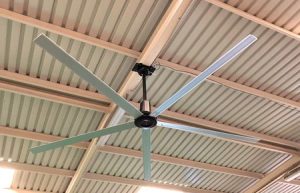High-Volume Low-Speed (HVLS) fans are revolutionizing air circulation in large spaces like warehouses, industrial facilities, and commercial buildings. This comprehensive guide explores what HVLS fans are, how they work, and why they’re essential for improving comfort and energy efficiency in vast indoor environments.
Struggling with stuffy air and high energy bills in your large facility? Inefficient air movement can lead to uncomfortable working conditions and increased operational costs. HVLS fans offer an effective solution by enhancing airflow and promoting energy savings.
So, what does HVLS mean in fans? HVLS stands for High-Volume Low-Speed. An HVLS fan is a large-diameter industrial fan that moves a high volume of air at a low rotational speed. Unlike smaller fans that spin rapidly without effectively circulating air in big spaces, HVLS fans gently push large amounts of air over extensive areas, improving airflow and indoor comfort.

HVLS fans work on a simple yet efficient principle: moving a significant volume of air at a slow speed. These fans have a diameter ranging from 7 feet to as much as 24 feet. The large diameter allows the fan to move more air than smaller fans. When an HVLS fan spins, it creates a column of air that flows down to the floor and outward in all directions, circulating air throughout the entire space.
This gentle but massive air movement helps to eliminate stationary air, reducing temperature stratification and creating a more uniform environment. Because they operate at a low speed, HVLS fans consume less energy compared to multiple high-speed fans, leading to substantial energy savings.
By moving large volumes of air, HVLS fans improve airflow dramatically. This increased air movement can make a space feel up to 7 degrees Fahrenheit cooler due to the cooling effect of air moving across the skin. In the winter, HVLS fans can be used to destratify warm air that rises to the ceiling, pushing it back down to occupant level.
HVLS fans are designed to be energy-efficient. The low rotational speed means they use less energy to move more air. Facilities that have installed HVLS fans often report significant energy savings, as these fans reduce the reliance on heating and cooling systems. According to studies, the energy required to drive a fan increases with the cube of the rotational speed, so operating at a low speed saves energy.
A comfortable environment enhances worker satisfaction and efficiency. By maintaining optimal temperatures and improving air quality, HVLS fans contribute to increased productivity. Employees are less likely to experience heat stress and discomfort, leading to better performance.
The primary difference between HVLS fans and smaller fans lies in their size and operating speed. While smaller fans spin quickly to move air, they can’t circulate air effectively in large spaces. HVLS fans, with their large diameter and low-speed operation, move air more efficiently across vast areas.
In spaces like warehouses, maintaining consistent temperatures is challenging. HVLS fans help to evenly distribute conditioned air, reducing hot and cold spots. This not only improves comfort but also protects temperature-sensitive inventory.
Industrial settings often generate heat due to machinery. HVLS fans circulate air efficiently, mitigating heat buildup and improving air quality. This leads to a safer, more comfortable workplace.
In commercial spaces such as malls, airports, and gyms, HVLS ceiling fans enhance airflow and contribute to a pleasant environment for customers and employees alike.
Large communal areas like gymnasiums benefit from the air movement provided by HVLS fans. They help maintain comfortable temperatures during events and reduce reliance on HVAC systems.

HVLS fans work synergistically with existing HVAC systems:
When choosing an HVLS fan, consider:
Proper installation is crucial for optimal performance:
HVLS fans are built robustly, requiring minimal maintenance compared to multiple smaller fans.
The airflow pattern of an HVLS fan is unique. The fan produces a floor jet of air that moves outward in a 360-degree pattern before rising back toward the ceiling. This circulation ensures that the entire space benefits from improved air movement.
What is an HVLS fan and how does it differ from a regular ceiling fan?
An HVLS fan is a High-Volume Low-Speed fan with a large diameter that moves a substantial volume of air at a slow speed. Unlike regular ceiling fans which are smaller and spin faster, HVLS fans are designed for large spaces and provide more efficient air movement.
How do HVLS fans contribute to energy savings?
By enhancing airflow, HVLS fans reduce the need for constant heating or cooling. They work with HVAC systems to distribute air more evenly, leading to significant energy savings due to reduced load on HVAC equipment.
Can HVLS fans be used in all seasons?
Yes, HVLS fans are useful year-round. In summer, they provide a cooling effect by increasing air movement. In winter, they assist with destratification, moving warm air trapped near the ceiling down to occupant level.
Are HVLS fans noisy?
No, HVLS fans operate quietly due to their low-speed design. This makes them suitable for environments where noise levels need to be minimized, such as educational institutions and offices.
Do HVLS fans require special maintenance?
HVLS fans are built to be durable and require minimal maintenance. Regular inspections and cleaning ensure optimal performance and longevity.
HVLS fans are a game-changer for large industrial and commercial spaces. They:
By investing in HVLS fans, facilities can achieve a more comfortable environment, reduce operational costs, and support a sustainable approach to climate control.

Hi, I’m Michael Danielsson, CEO of Vindus Fans, with over 15 years of experience in the engineering and design industry. I’m here to share what I’ve learned. If you have any questions, feel free to contact me at any time. Let’s grow together!